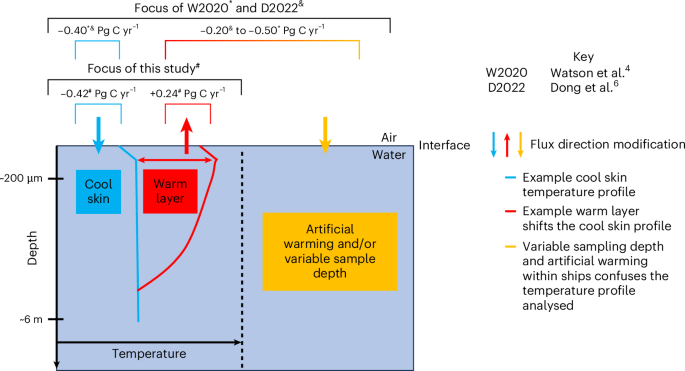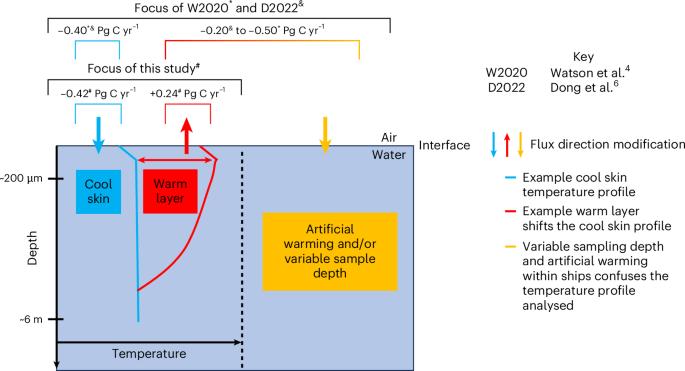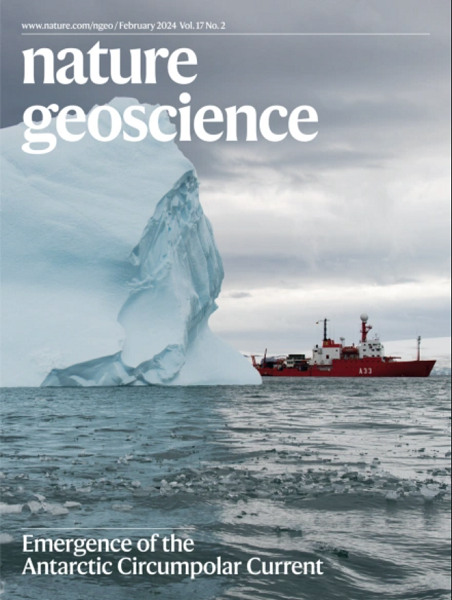近表层温度梯度导致海洋二氧化碳吸收增强
IF 15.7
1区 地球科学
Q1 GEOSCIENCES, MULTIDISCIPLINARY
引用次数: 0
摘要
海洋每年吸收约四分之一的人为二氧化碳(CO2)排放量。对海气二氧化碳通量的全球估算通常基于对空气和海水中二氧化碳总量的测量,忽略了海洋表面附近垂直温度梯度的影响。理论和实验室观测表明,这些梯度会改变海气二氧化碳通量,因为海气二氧化碳浓度差对温度高度敏感。然而,迄今为止还缺乏支持其影响的实地证据。在此,我们介绍了 2018 年和 2019 年在大西洋(北纬 50 度至南纬 50 度)沿重复横断面收集的独立直接海气二氧化碳通量以及间接散装通量。我们发现,考虑到垂直温度梯度,直接通量与间接通量之间的差异从 0.19 mmol m-2 d-1 降至 0.08 mmol m-2 d-1 (N = 148)。这意味着大西洋二氧化碳汇增加了约 0.03 PgC yr-1(约为大西洋汇的 7%)。这些实地结果验证了理论、建模和基于观测的努力,所有这些努力都预测,考虑近地表温度梯度将增加全球海洋二氧化碳吸收量的估计值。考虑到这一增加的海洋吸收量,可能需要对全球碳预算的量化方式进行一些修改。本文章由计算机程序翻译,如有差异,请以英文原文为准。


Enhanced ocean CO2 uptake due to near-surface temperature gradients
The ocean annually absorbs about a quarter of all anthropogenic carbon dioxide (CO2) emissions. Global estimates of air–sea CO2 fluxes are typically based on bulk measurements of CO2 in air and seawater and neglect the effects of vertical temperature gradients near the ocean surface. Theoretical and laboratory observations indicate that these gradients alter air–sea CO2 fluxes, because the air–sea CO2 concentration difference is highly temperature sensitive. However, in situ field evidence supporting their effect is so far lacking. Here we present independent direct air–sea CO2 fluxes alongside indirect bulk fluxes collected along repeat transects in the Atlantic Ocean (50° N to 50° S) in 2018 and 2019. We find that accounting for vertical temperature gradients reduces the difference between direct and indirect fluxes from 0.19 mmol m−2 d−1 to 0.08 mmol m−2 d−1 (N = 148). This implies an increase in the Atlantic CO2 sink of ~0.03 PgC yr−1 (~7% of the Atlantic Ocean sink). These field results validate theoretical, modelling and observational-based efforts, all of which predicted that accounting for near-surface temperature gradients would increase estimates of global ocean CO2 uptake. Accounting for this increased ocean uptake will probably require some revision to how global carbon budgets are quantified. Accounting for near-surface temperature gradients leads to estimates for annual CO2 uptake in the North Atlantic that are 7% higher, based on a comparison of eddy covariance and bulk CO2 measurements, which is consistent with theory, laboratory assessments and model analysis.
求助全文
通过发布文献求助,成功后即可免费获取论文全文。
去求助
来源期刊

Nature Geoscience
地学-地球科学综合
CiteScore
26.70
自引率
1.60%
发文量
187
审稿时长
3.3 months
期刊介绍:
Nature Geoscience is a monthly interdisciplinary journal that gathers top-tier research spanning Earth Sciences and related fields.
The journal covers all geoscience disciplines, including fieldwork, modeling, and theoretical studies.
Topics include atmospheric science, biogeochemistry, climate science, geobiology, geochemistry, geoinformatics, remote sensing, geology, geomagnetism, paleomagnetism, geomorphology, geophysics, glaciology, hydrology, limnology, mineralogy, oceanography, paleontology, paleoclimatology, paleoceanography, petrology, planetary science, seismology, space physics, tectonics, and volcanology.
Nature Geoscience upholds its commitment to publishing significant, high-quality Earth Sciences research through fair, rapid, and rigorous peer review, overseen by a team of full-time professional editors.
 求助内容:
求助内容: 应助结果提醒方式:
应助结果提醒方式:


